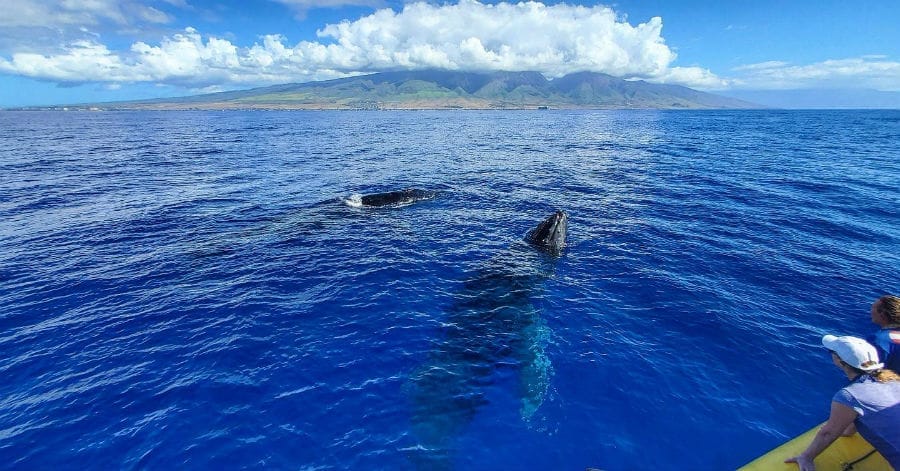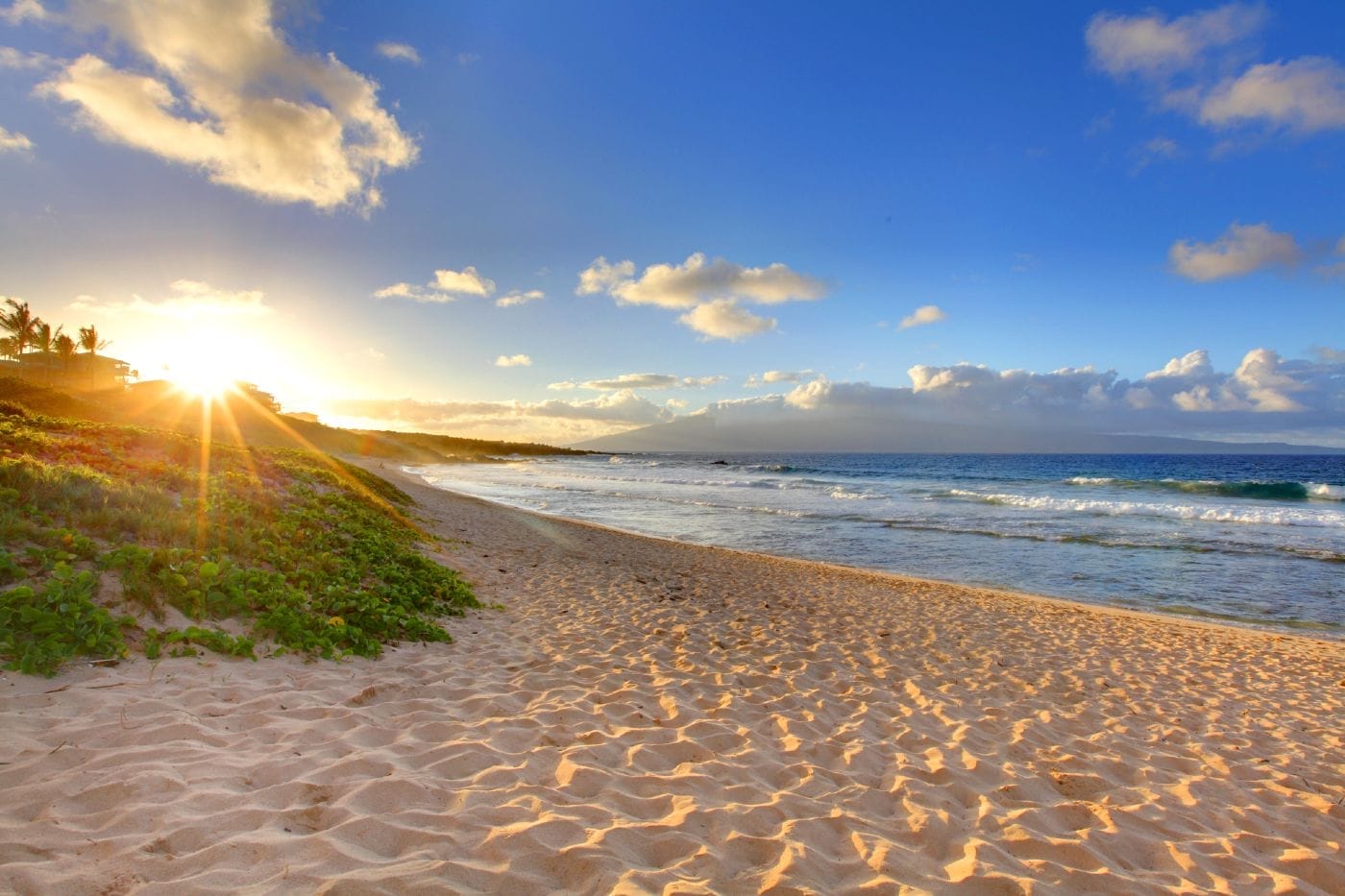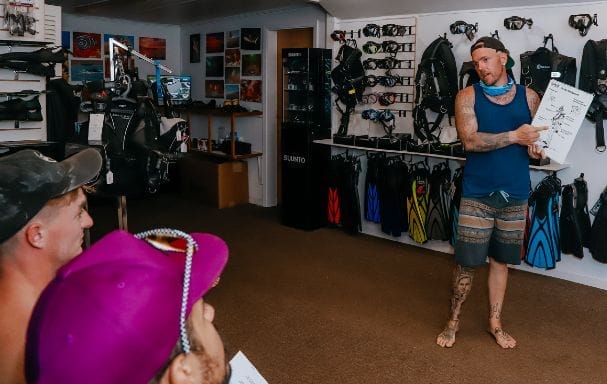Maui Whale Watching Season: Everything You Need to Know
This article was originally published on December 28, 2021. We update it regularly to keep the information accurate and relevant. The most recent update was made on September 20, 2025.
Table of Contents
Whale watching on Maui ranks among the island’s most unforgettable natural spectacles, providing a unique opportunity to witness the beauty of ocean wildlife. Every winter, between 8,000 and 12,000 humpback whales travel nearly 3,600 miles from the icy waters of Alaska to the warm channels around Hawaii. Maui sits at the center of this migration. From December through May, the ocean fills with breaches, tail slaps, and the deep sound of whale songs. These giants do not feed while in Hawaii; they save their energy for breeding, giving birth, and raising calves.
If you wonder when the season begins, what time of year is best, and how to make the most of your trip, this guide lays out everything you need to know.
The first annual sighting of Humpback whales is an eagerly anticipated event each year and commonly occurs by late November. The season officially begins on December 15th, through mid-February is generally considered the season’s peak.
Now that we know roughly when whale watching season begins, let’s look at some of the details to help you get the most out of any whale watching experience. Below, we will look at what you can expect during Maui’s whale watching season, how to maximize your chances of seeing a whale, and more of your most frequently asked questions! So, if a whale watching excursion is something you dream of, be sure to read on to see how it can become a reality!

When Does Maui’s Whale Watching Season Start and End?
As stated above, Maui’s whale watching season can be broken roughly into three different periods. Let’s look at each one in a little more depth below.
- First sightings: The first whale sightings are an eagerly anticipated event that usually occurs in late November or early December, though seeing a whale earlier is not uncommon. Nature occasionally surprises us. In July 2025, Dive Maui’s team recorded a rare sighting of a healthy humpback off Lahaina—the first documented whale that summer. Encounters like this are unusual, and most whales follow their regular migration schedule, but it shows just how unpredictable and exciting Maui’s waters can be.
- Start of the season: Whale watching really kicks into high gear on the island around December 15th, considered the traditional start of the season by many. It is after this date that you have the best chance of seeing a whale in the wild.
- Peak whale watching season: The middle of February is generally considered the peak of the season, with abundant opportunities to see whales in the water. And though this may be the peak, the height of the season is sustained for some time, with whales continuing to be sighted through April and into May.
What Are the Best Months for Whale Watching on Maui?
February brings the most breaching activity, with constant spyhops and males fighting for females. January and March also offer prime whale watching with slightly fewer boats on the water. December creates excitement as the first arrivals show up. April is quieter but special: this is when mothers guide calves in shallow waters, and visitors often see young whales practicing their first breaches.
What Can I Expect to See on a Whale Watching Excursion?
The most common type of whale sighted are the majestic Humpback Whales which are attracted to the warm waters that surround the island, especially in the Au’au Channel, which lays between Maui and Lana’i. Humpback whales weigh up to 40 tons and stretch 50 to 60 feet long. Watching one leap completely out of the water is breathtaking. They also slap tails, wave pectoral fins, and rise vertically in spyhops to look around. Males clash for dominance, while others escort mothers and calves. Later in the season, encounters with young whales become more frequent. Close encounters sometimes occur when whales surround boats. Locals call this “whale mugging.” Federal law requires vessels to stay 100 yards away, but the whales often choose to approach.
Other whales that can be found in the area include Pilot Whales and False Killer Whales, though both of these species are much, much more rarely seen, contributing to the rich diversity of marine life in the region. And whales aren’t the only aquatic creatures you may find if you decide to whale watch during the shoulder season—fall and spring—during this time you will have an excellent chance of catching sight of dolphins and sea turtles.
Why Is Maui the Best Place in Hawaii to See Whales?
Whales travel throughout the Hawaiian Islands each winter, but nowhere matches Maui for consistent encounters. The reason lies in geography. The Auʻau Channel and the larger Maui Nui Basin stretch between Maui, Lānaʻi, Molokaʻi, and Kahoʻolawe. This sheltered stretch of ocean covers roughly 320 square kilometers, with depths often less than 180 meters. The calm, warm waters provide ideal conditions for breeding, birthing, and raising calves.
For humpback whales, shallow water means fewer predators and calmer seas for their newborns. Mothers guide calves close to shore, sometimes so near that people standing on the beach can spot spouts or even tails breaking the surface. Scientists estimate that more than two-thirds of the North Pacific humpback whale population visits Hawaii each year, and Maui sees the highest concentrations.
The island’s culture also plays a role in why whale watching here feels so special. Humpbacks, known in Hawaiian as koholā, hold a sacred place in local traditions. They appear in legends, chants, and artifacts as symbols of strength and protection. Watching them breach against the backdrop of the West Maui Mountains or Haleakalā is more than wildlife viewing—it’s a glimpse into a natural rhythm that has shaped island life for centuries.
💡 Did you know?
In July 2025, Dive Maui’s team spotted a humpback whale off Lahaina—months after the season had ended. The whale looked healthy, just “late to the party.” Such summer sightings are extremely rare, but they show how unpredictable and thrilling Maui’s waters can be.
Where Are the Best Places to See Whales on Maui?
Whale sightings from land are common. McGregor Point Lookout near Maʻalaea, the beaches of Kāʻanapali, and the shoreline in Kīhei and Lahaina are excellent viewing spots. Highway 30’s scenic lookout provides wide ocean views and convenient parking. Bring binoculars and watch for spouts.
On the water, choices abound. Larger boats often depart from Maʻalaea Harbor or Lahaina Harbor. Kāʻanapali Beach offers catamaran tours that board directly from the sand, convenient for resort guests though less accessible for anyone with mobility challenges. In South Maui, small boats depart from the Kīhei Boat Ramp.
If you want a more intimate trip, Dive Maui runs daily whale watching tours from Lahaina with small groups of no more than 20 guests. Their fast boat rides low in the water, so you feel close to the whales, and naturalist guides share stories and science about Maui’s humpbacks.

Early, Peak, and Late Season: What’s the Difference?
December’s early arrivals spark anticipation. Peak season from January through March brings constant action and guaranteed sightings, but also the busiest tours. April and May move at a slower pace. Mothers and calves dominate the waters, offering a more relaxed and intimate experience before the migration back north.
What’s the Best Time of Day to Go Whale Watching on Maui?
Morning tours between 6 and 8 a.m. usually provide the best conditions. Winds pick up around midday, and the water grows rougher. Early trips bring calmer seas, softer light, and smoother rides. Afternoon tours still deliver dramatic scenes, but expect choppier water.
Dive Maui offers multiple daily departures, starting at 6:45 a.m., which makes it easy to choose the time that fits your schedule.
How Do You Choose the Right Whale Watching Tour?
Choose your tour based on style. Families should pick larger boats with restrooms and shaded areas. Adventurers may prefer rafts or kayaks for close-to-the-water encounters.
For small-group trips, Dive Maui offers 1.5-hour and 2-hour tours priced from $50 for children and $70 for adults. Every trip includes hydrophones so guests can hear whale songs beneath the surface, plus rain ponchos if the weather turns – and with a money-back guarantee if you don’t see whales.
- In Hawaiian, humpback whales are called koholā.
- They are seen as ‘aumākua (ancestral guardians) and linked to Kanaloa, god of the ocean.
- Humpbacks feature in chants, carvings, and ceremonial objects from the Polynesian era.
The Best Way to Whale Watch on Maui
The answer to this question will boil down to personal preference. Some will enjoy looking for whales from land or a canoe, however, if you want to maximize your chances of seeing a whale in open waters, we highly recommend taking a whale watching trip on Maui with an experienced provider who is committed to protecting our ocean’s environment, just as we are here at Dive Maui.
Our whale watching tours are an intimate, full-service experience that lasts approximately 2 hours, with multiple tours offered each day. The chance to see one of the thousands of Humpbacks that migrate to Maui each year up close and personal is sure to be a highlight of any vacation. And we are so confident that we will be able to deliver a superior whale watching experience that we guarantee you will see a whale on your trip.
Whale Watching with Kids
Whale watching is an excellent activity for the whole family, offering a chance to learn about Maui’s “Must See” aquatic Life, observe fascinating whale behavior up close, and appreciate the diversity of ocean wildlife of Maui. Many children are enthralled in the “hunt” to be the first to glimpse a whale and seeing such wonderful creatures up close is impactful no matter one’s age. Additionally, whale watching is a great time to teach children practically about the importance of conservation. The Humpback Whale National Marine Sanctuary Visitor Center in Kīhei is also a family highlight. Open on weekdays, it features interactive exhibits, hands-on learning, and an outdoor platform with ocean views.
Not sure if your kids will be into whale watching? Show them this video and ask if they might like to see a Humpback in real life, in our experience the answer is almost always an enthusiastic yes! Dive Maui keeps family trips engaging, with enthusiastic crew members who love to share their passion for Maui’s humpbacks.
How Should You Prepare for a Whale Watching Trip?
Dress in layers to handle cool mornings and warm afternoons. Sunscreen, sunglasses, and a hat protect you from the sun. Bring water, snacks, and a camera or binoculars.
Take motion sickness medication before boarding if needed. Avoid small rafts if you have back problems, since they bounce more on rough seas. Boarding catamarans at Kāʻanapali involves climbing stairs directly in the surf, so plan footwear and mobility needs in advance.
What Rules Protect the Whales?
Federal law protects humpback whales in Hawaii. Boats must stay 100 yards away, and swimming with whales is forbidden. When whales approach on their own, crews must wait until they leave.
Many tours use hydrophones, underwater microphones that pick up whale songs. Each winter, males create a new song that all of them repeat. These haunting calls last up to 40 minutes and travel for miles. Dive Maui includes this feature in every trip, so guests not only see whales but also hear them.
When Should You Book your Whale Watching trip?
Peak season tours often sell out, especially morning trips. Book weeks in advance for February. In December or April, tours have more availability, but booking early still guarantees your preferred time. Dive Maui runs tours daily from December 16 to April 13, with a money-back guarantee if you don’t see whales.
We’re Always Here to Help!
To wrap things up, whale watching season is one of our favorite times of the year and we hope to be able to make it a highlight of yours as well. We hope you agree that chance to see a whale in person is something no one should pass up.
Do you have more questions about whale watching? Please don’t hesitate to reach out to us today! We hope you’ve enjoyed reading more about Maui’s whale watching opportunities and that you’ve learned something new along the way. As always, thank you for reading, and until next time Aloha!







